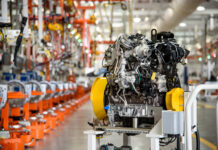The spotlight at Automechanika Johannesburg 2017’s launch last month focused on South Africa’s automotive sector – and, despite the country’s economic downturn, much of the news was positive.
While South Africa works its way through the impact of the latest economic headwinds, the automotive sector is holding its own in a volatile market, Econometrix director and chief economist, Dr Azar Jaminne, said in a keynote address last month at a breakfast to launch Automechanika Johannesburg 2017.
Jaminne said despite an expected contraction in domestic vehicle production and sales for this year, the automotive sector would remain a significant contributor to the country’s exports, with ample opportunities for further growth in Africa opening up opportunities for the components and parts sector.
He said it was expected that new passenger vehicle output would contract this year by 2,9%, that of light commercial vehicles (LCVs) by 1,9%, medium commercial vehicles (MCVs) by 1,2% and heavy commercial vehicles (HCVs) by 0,7%.
However, by 2018, he believed production would swing back into the positive, with passenger vehicle production growing by 2,9% along with increases of 0,4% and 0,8% respectively expected for LCVs and MCVs. According to his reckoning, there would be no growth in the HCV sector.
Further, the downward trend in sales, following a hammering of the new vehicle sales market over the past few years, would positively benefit the parts and components sector in the medium term. “Given the fact that there is traditionally a three- to five-year lag between new vehicle sales and replacement parts, this suggests that, by 2020 or so, we could see quite a boom in the parts industry, both for LCVs and HCVs,” he said.
In addition, the automotive sector was experiencing growth within the overall lacklustre manufacturing industry. “While manufacturing itself is going nowhere fast at 0%, the share of the automotive industry within overall manufacturing keeps rising. Including parts, this translates into an improvement in the automotive industry’s share of gross domestic product.”
Jaminne said South Africa remained easily the biggest vehicle market in Africa – accounting for 37% of passenger vehicle sales and 56% of commercial vehicle sales in 2016 – followed by Egypt and Morocco.
The automotive export share as a percentage of South Africa’s total mechanise export had risen to an all-time high at 15,6% and the country’s export markets – including Germany, Belgium and the UK – remained strong, with the European Union accounting for 50% of the country’s exports.
However, exports to Africa were also rising, the continent currently accounting for 18% of the country’s automotive exports. “There are outstanding export prospects immediately to the north of us, as other African economies, particularly East Africa, boast attractive economic growth over the next few years,” Jaminne said.
Further, South Africa’s trade balance had also improved, contracting from a deficit of R42,3-billion in 2012 to R32,9-billion in 2016. Automotive imports were up 48,7% from 2012 to 2016 and exports up 80,3% over the same period.
“So, relatively speaking, the automotive sector is holding itself well in terms of trade with other countries,” he commented.














